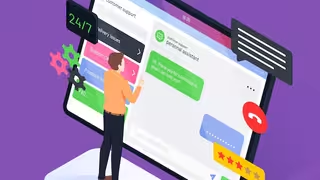Step-by-Step Guide to Launching Your First Product

Launching your first product is an exciting yet challenging milestone for any business. Whether you’re developing a physical product or a digital service, careful planning and execution are essential to ensure its success. This step-by-step guide will walk you through the key stages of a product launch, from idea conception to post-launch strategies, helping you to avoid common pitfalls and maximise your chances of success.
1. Identify a Market Need
Before you invest time and money into developing a product, it’s essential to ensure there is a demand for it. Start by identifying a problem or need within your target market. This can be done through market research, competitor analysis, and customer feedback.
Ask yourself questions like:
- What problem does my product solve?
- Who will benefit from this solution?
- How does my product differ from competitors?
Once you’ve identified a market need, validate your idea by talking to potential customers. Conduct surveys, focus groups, or interviews to gauge interest in your product concept and understand any concerns or preferences they may have.
2. Research Your Target Audience
Knowing your audience is crucial for a successful product launch. Create detailed buyer personas to represent your ideal customers, based on age, gender, occupation, income level, and purchasing behaviour. This helps tailor your product and marketing strategy to the needs and preferences of the people most likely to buy your product.
For example, if you’re launching a fitness app, your target audience might include young professionals who prioritise health and fitness but have limited time for the gym. By understanding your audience’s pain points, you can better position your product to solve their specific challenges.
3. Develop a Unique Value Proposition (UVP)
Your product’s unique value proposition (UVP) is what sets it apart from competitors. It’s a clear statement that explains the benefits of your product, how it solves customer problems, and why it’s better than other available solutions.
A strong UVP should be:
- Clear: Concisely explain what makes your product special.
- Specific: Focus on the unique features or benefits your product offers.
- Customer-focused: Highlight how the product will improve the user’s life or work.
For instance, if you’re launching an eco-friendly water bottle, your UVP could focus on its durability, sustainability, and ability to keep drinks cold for 24 hours—attributes that resonate with environmentally conscious consumers.
4. Create a Prototype or Minimum Viable Product (MVP)
Once you’ve established the product idea, it’s time to create a prototype or Minimum Viable Product (MVP). An MVP is a basic version of your product with enough features to attract early adopters and gather feedback.
The goal of an MVP is to test your concept in the market without a full-scale investment in development. This allows you to learn how customers interact with your product and make improvements based on real-world use.
For example, if you’re launching a new mobile app, you might release a version with limited functionality to test user engagement before adding more features. This feedback loop helps refine the product and ensures it meets customer expectations before the final launch.
5. Develop a Go-to-Market Strategy
Your go-to-market strategy is the plan that outlines how you will introduce your product to your target audience and achieve competitive advantage. It involves defining your pricing, distribution channels, and promotional tactics.
Pricing Strategy: Decide on a pricing model that reflects the value of your product while remaining competitive. Consider whether you’ll offer discounts, bundles, or subscription options.
Distribution Channels: Determine how and where customers will buy your product. Will you sell online through your website or third-party platforms like Amazon? Will your product be available in physical stores?
Promotion: Plan how you’ll create awareness and excitement around your launch. This may involve email marketing, social media campaigns, paid advertising, or influencer partnerships.
For a successful launch, align your promotion strategy with your target audience’s preferences. If you’re launching a product aimed at younger demographics, social media platforms like Instagram or TikTok may be the most effective way to reach potential buyers.
6. Test Your Product Before Launch
Before officially launching your product, it’s essential to test it thoroughly. This helps you identify any issues and ensure everything works as expected. Testing can be done in several ways:
- Beta Testing: Allow a small group of users to try the product in exchange for feedback.
- Usability Testing: Observe how users interact with your product to identify potential improvements.
- Soft Launch: Introduce the product in a smaller market or to a limited audience to gather insights before a full-scale launch.
Testing allows you to make final adjustments and increases the likelihood of a successful launch, as you’ll be able to address any last-minute bugs or customer concerns.
7. Plan Your Launch Day
Launch day is your opportunity to make a big splash and create excitement around your product. It’s important to have a well-coordinated launch plan that involves all key stakeholders, including your marketing team, salespeople, and customer support team.
Here are some steps to consider for launch day:
- Announce the Launch: Use email marketing, social media, and press releases to announce your product’s availability.
- Host an Event: Consider hosting a live event, such as a webinar or in-person demo, to showcase your product and generate buzz.
- Offer Incentives: Encourage customers to make a purchase by offering limited-time discounts, free trials, or bonus gifts for early buyers.
Ensure you have enough inventory to meet demand, and prepare your customer support team to handle questions or technical issues that may arise during the initial launch period.
8. Gather Feedback and Make Improvements
The work doesn’t stop after your product is launched. Post-launch feedback is invaluable in helping you refine your product and better understand your customers’ needs. Encourage customers to leave reviews, participate in surveys, or provide feedback directly through email or support channels.
Use this feedback to make any necessary product improvements and refine your marketing strategy. It’s also helpful to monitor key performance metrics such as sales, customer acquisition costs, and website traffic to gauge the success of your launch.
9. Plan for Long-Term Growth
After the initial excitement of your product launch, focus on maintaining momentum and planning for long-term growth. This might involve expanding your product range, exploring new distribution channels, or targeting new customer segments.
Additionally, keep investing in customer retention by providing excellent customer service and regularly engaging with your audience through email marketing, social media, or loyalty programmes.
In conclusion, launching your first product involves careful planning, from identifying a market need to gathering post-launch feedback. By following this step-by-step guide, you can navigate the complexities of product development and ensure your launch is a success. Remember that product launches are rarely perfect, so be open to learning from the process and continuously improving your approach.










